
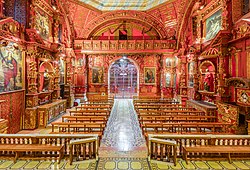
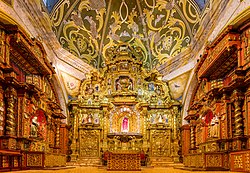
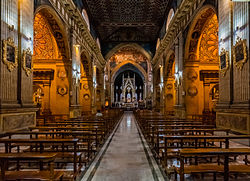
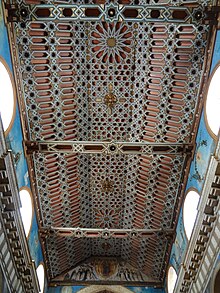

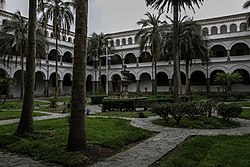
The Church of Santo Domingo is a Catholic church in the historic center of the city of Quito, capital of Ecuador. The complex of convent, church and chapels is located on the Plaza de Santo Domingo, itself named after the church.







The Church of Santo Domingo is a Catholic church in the historic center of the city of Quito, capital of Ecuador. The complex of convent, church and chapels is located on the Plaza de Santo Domingo, itself named after the church.
Its construction began in 1540, when the site was assigned to the community of Dominican fathers; Later, and after a provisional chapel was built, the definitive plans of the temple that persist to the present day were drawn up in 1581 [3] by the architect Francisco Becerra. After Becerra's death, the work passed into the hands of Father Rodrigo Manrique de Lara; Friar Antonio Rodríguez was in charge of the works of the convent, while Friar Juan Mantilla was in charge of completing the works of the church in 1688.
The church is covered in cedar work covered with gold leaf, and numerous paintings and carvings adorn its interior. Along with the main altarpiece, the ten side chapels that complete the interior complex of Santo Domingo further enrich the internal body of the church with beautiful woodwork and gold leaf.
Undoubtedly, the Chapel of the Virgen del Rosario is the best known of the complex; However, it is not the only one that shows the cultural interest of the temple, as Pazos Barrera indicates: "in another chapel, the mural painting of the Virgin of the Staircase, the work of Father Pedro Bedón and dating from the early years of the 17th century, is preserved.".
The Cloister, for its part, has corridors and bays with double arches with octagonal pillars, and is due to brother Antonio Rodríguez, who built it based on the design of Francisco Becerra.

As in other churches and civil constructions in the city of Quito, the builders of Santo Domingo found themselves from the beginning with an abrupt and uneven terrain, for which they had to invent various architectural solutions to give continuity to the main temple and especially to the chapels; from there was born the famous Arch of Santo Domingo, on which is the Chapel of the Virgen del Rosario, and through whose base runs, without interruption, calle Rocafuerte. The Arch of Santo Domingo was built in 1732. [1]
The Plaza de Santo Domingo is in front of the Church. In the center stands a monument to Marshal Antonio José de Sucre, Venezuelan hero of the Independence. Around the Plaza, in addition to the Church and the convent, there are important civil buildings, such as the old Colonial University of Santo Tomás de Aquino and the mansion of former president Gabriel García Moreno. The Plaza has an area of approximately 7,200 square meters, with sides measuring approximately 85 meters in linear meters. Like the other squares in the city, it was originally a simple esplanade, and was later converted into a park and a bus station. Today it is an esplanade paved with stone.
The richest and most well-known of the chapels of the church of Santo Domingo is the Chapel del Rosario, which is located towards the south side of the transept, and which is built on three different levels. This chapel overlooks the old street of La Loma (today called Rocafuerte), where to solve another unevenness in the land, the architects built the Arch of Santo Domingo, with cone-shaped buttresses that evoke lookout posts.
The three levels of the chapel respond to a kind of stratification: the lowest was intended for the common citizen, the second for the priest and the authorities, and the third for the Virgin of the Rosary. Since 1650, three confraternities worked in this chapel; [4] the first of peninsular Spaniards and Spaniards born in America (criollos), the second of black and mestizo edges, and finally another formed entirely by indigenous people. Each group had its corresponding space in a kind of smaller chapels. The Chapel of la Virgen del Rosario was finished in 1732. [1]
The Virgin and Child, whose mantles and crowns are rich in precious threads and precious stones, star in the composition of the altarpiece; the latter is described by Pazos Barrera with the following terms: [2]
(...) Entirely gilded, [3] it has silver filigree around the central niche and in the tabernacle. In it, the Virgen del Rosario stands out, a Spanish sculpture that was a gift from the Spanish monarch in the 16th century. On the sides of the altarpiece are the altarpieces of Saint Anne and Saint Joachim, gilded on a red background. Arches and walls have applications of cherubs, American plants and fruits, covered in gold on a red background. The Chapel of the Virgin of the Rosary rests on an arch through which the street that leads to the La Loma Grande neighborhood passes. The chapel is closed by two domes with lanterns covered with green tiles.
Relics of saints are preserved in the side altars of this chapel, brought from Rome at the very beginning of the foundation of Quito. With them, the rituals of the Confraternity of the Rosario de Nuestra Señora were fulfilled and the Procession of Solitude was carried out, on Good Friday, both of great devotion in the city. In the opinion of the experts, in the decoration of the Chapel of the Rosary a Baroque saturation derived from the ornamental abundance is reached.
Within the Cloister of the Santo Domingo complex, located at the north end of the main church, and on the square, a space has been designated to turn it into a museum open to the public. According to the description of Julio Pazos Barrera: [5]
On the north side of the cloister of the Church of Santo Domingo, a Museum and Library have been installed. The museum exhibits carvings and paintings related to the history of the Dominicans in America; It also houses a large choral book laminated by Father Pedro Bedón and two of his paintings, as well as a portrait by Alonso del Castillo of the late Father Bedón. Two other places attract attention: the chapel of la Virgen de Pompeya or the choir room and the refectory, the latter, decorated in the 17th century with a polychrome and gilt Mudéjar artesonado and paintings of Dominican martyrs. In this refectory, carved, incarnated and stewed tables of Dominican saints, by the Spanish sculptor Diego de Robles, are exhibited. These carvings, from the year 1600, were found in the high choir of the temple, which was dismantled in the 19th century.

Both inside the Museum, as well as in the Convent and the main temple with its chapels, the Santo Domingo complex houses a large number of works of art from the Colonial Quito School of Art, especially, and other arrivals from Europe and other Hispanic colonies in America. Among them we can name the following:
| Type of work | Name | Author | Epoch |
|---|---|---|---|
| Book | Gran libro coral (Choral big book) | Friar Pedro Bedón | 16th century [2] |
| Sculpture | Virgen del Rosario (Virgin of the Rosary) | Unknown (Spaniard origin) | 16th century [2] |
| Mural | Virgen de la Escalera (Virgin of the Staircase) | Friar Pedro Bedón | 17th century |
| Painting | Retrato de Pedro Bedón tras su muerte (Portrait of Pedro Bedón after his death) | Alonso del Castillo | 17th century |
| Sculpture | San Reginaldo de Orleans (St. Reginald of Orleans) | Padre Carlos | 17th century |
| Painting | La Virgen de las flores (The Virgin of the flowers) | Isabel de Santiago | 17th century [6] |
| Sculpture | Virgen Inmaculada (Immaculate Virgin) | Bernardo de Legarda | 18th century |
| Reredos | Virgen del Rosario (Virgin of the Rosary) | Bernardo de Legarda | 18th century |
| Painting | Los Reyes de Judá (The Kings of Judah) (series of 18 paintings in the Refectory) | Nicolás Javier de Goríbar | 18th century [7] |

The Church and Convent of Santo Domingo de Guzmán in the city of Oaxaca de Juárez (Mexico) is an example of New Spanish Baroque architecture. The first construction projects for the building date back to 1551, when the Antequera de Oaxaca's City Council ceded a total of twenty-four lots to the Dominican Order for the construction of a convent in the city. However, it was not until 1608 that the conventual complex of Santo Domingo was inaugurated, still unfinished.
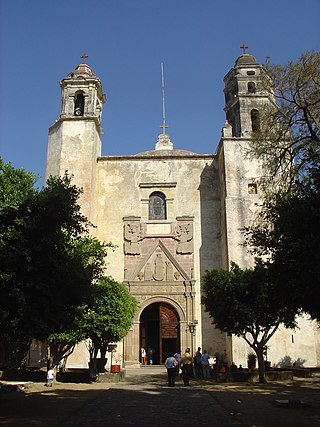
The Earliest Monasteries on the Slopes of Popocatepetl are sixteen earliest 16th-century monasteries which were built by the Augustinians, the Franciscans and the Dominicans in order to evangelize the areas south and east of the Popocatépetl volcano in central Mexico. These monasteries were recognized by the UNESCO as World Heritage Sites in 1994, because they served as the model for the early monastery and church buildings as well as evangelization efforts in New Spain and some points beyond in Latin America. These monasteries almost uniformly feature a very large atrium in front of a single nave church with a capilla abierta or open chapel. The atrium functioned as the meeting point between the indigenous peoples and the missionary friars, with mass for the newly converted held outdoors instead of within the church. This arrangement can be found repeated in other areas of Mexico as these friars continued to branch out over New Spain.

The Quito Metropolitan Cathedral, is a Catholic cathedral in Quito, Ecuador. Located on the southwestern side of the Plaza de la Independencia, it served as a seat of the Diocese of Quito from 1545 until 1848 when it was elevated to Archdiocese. In 1995, it was elevated to the Cathedral of Ecuador, making it the seniormost Catholic church in the country.

Santo Domingo in Mexico City refers to the Church of Santo Domingo and its Plaza, also called Santo Domingo. Both are located three blocks north of the Mexico City Metropolitan Cathedral following República de Brasil Street with Belisario Dominguez Street separating the two.
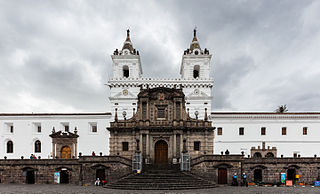
The Basilica and Convent of San Francisco, commonly known as el San Francisco, is a Catholic basilica that stands in the middle of the historic center of Quito, in front of the square of the same name. It is the oldest and most significant religious site in Ecuador. The structure is the largest architectural complex within the historic centers of all of South America, and for this reason it was known as "El Escorial of the New World". San Francisco is considered a jewel of continental architecture for its mixture of different styles combined throughout more than 150 years of construction. San Francisco is part of the UNESCO World Heritage Site "City of Quito".
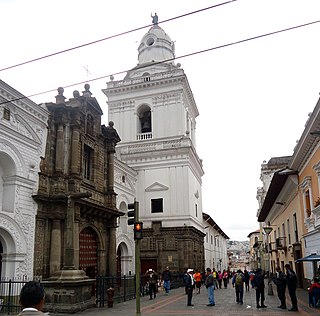
The Church and convent of San Agustín is a Catholic temple located in the Historic Center of the city of Quito, run by the Augustinian Order. The complex of the temple and convent is located on calle Chile, between Guayaquil and Flores.
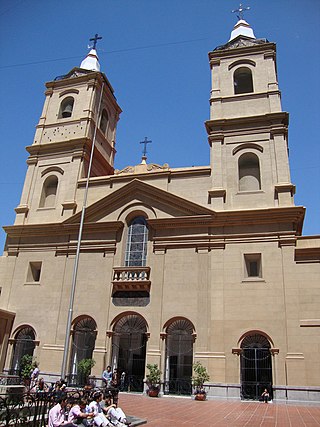
The Santo Domingo Convent, or Basilic of Our Lady of the Rosary and Convent of Santo Domingo is a convent for Our Lady of the Rosary located in the Monserrat neighborhood of Buenos Aires. Built during the colonial times, it was the scenario of a military conflict during the British invasions of the Río de la Plata. It holds as well the tomb of the Argentine national hero Manuel Belgrano.

The Basilica and Convent of Nuestra Señora de la Merced is a Roman Catholic church located in Lima, Peru. It was designed in the Baroque style known as Churrigueresque. The church was built under the supervision of Friar Miguel de Orenes in 1535. The Blessed Virgin Mary of Mercy, the patroness of the Peruvian Armed Forces, is venerated in the Basilica. The Mercedarians, who evangelized the region, helped to develop Lima by building many of the churches preserved today.

The Church and Convent of San Ignacio de Loyola de la Compañía de Jesús de Quito, also known in the Ecuadorian people simply as La Compañía, is a Catholic clerical complex located on the corner formed by calles García Moreno and Sucre, in the Historic Center of the city of Quito, capital of Ecuador. The façade of its main temple is entirely carved in volcanic stone. Over time, this church has also been called: "Temple of Solomon of South America". Father Bernardo Recio, a traveling Jesuit, called it "Golden Ember".

La Iglesia de El Sagrario is a Renaissance Catholic church in the city of Quito, capital of Ecuador. It is located in the Historic Center of the city, on calle García Moreno, formerly known as calle de las Siete Cruces, a few meters from the corner with calle Eugenio Espejo. It is part of the Metropolitan Cathedral complex, although it seems more like an independent church than an adjoining chapel, both because of its size and because of its importance in Quito's art.

Santo Domingo Church, formally known as the National Shrine of Our Lady of the Most Holy Rosary, is a Roman Catholic national shrine and parish church in Quezon City, Metro Manila in the Philippines. Dedicated to Mary, mother of Jesus under her title Our Lady of the Most Holy Rosary — La Naval de Manila, it was founded by the Dominicans in 1587.

The defunct Convento de Santo Tomás was a set of buildings belonging to the Dominicans, under the patronage of St. Thomas Aquinas, in Madrid.

The Iglesia de Santo Domingo de Guzmán it is a Roman Catholic church located in the city of San Cristóbal de La Laguna.

The Basilica and Maximus Convent of Nuestra Señora del Rosario, popularly known as the Convent of Santo Domingo, is a Catholic religious complex located in the city of Lima, Peru.

The Chapel of the Virgen del Rosario is the chapel attached to the Church of Santo Domingo in the city of Puebla, Puebla, Mexico. Work of the 17th century, summit of the New Spanish Baroque, was described in its time as the Eighth Wonder of the World by Friar Diego de Gorozpe, in a print of 1690, regarded like this for a long time in New Spain, as well as La Casa de Oro and Domus Aurea. It is one of the most prominent examples of the New Spanish Baroque and one of the greatest artistic-religious achievements in Mexico. It is a chapel full of symbolisms, where each element represents something related to the Catholicism and Dominican Order beliefs. It is located on pedestrian avenue 5 de Mayo number 407.
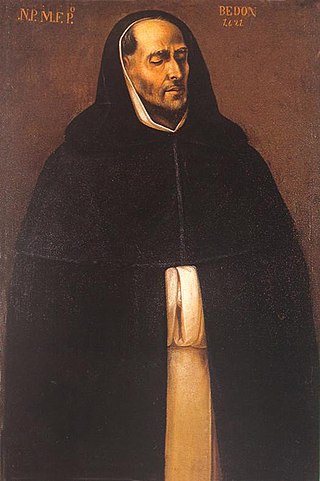
Fray Pedro Bedón Díaz de Pineda was a South American Dominican friar and painter of the Quito school.

The Church and Convent of los Dominicos of the Colonial City of Santo Domingo in the Dominican Republic, is the oldest Catholic building in continuous use in the Americas, and also, according to the UNESCO, it was the headquarters of the first university in the Americas, which was called the Universidad Santo Tomás de Aquino. Today it is part of the Colonial City complex, as a World Heritage Site.

The Dominican priory of La Guardia de Jaén, known from its dedication as the Convent of Santa María Magdalena de la Cruz, was founded for a community of friars of the Dominican Order in the town of La Guardia de Jaén in the province of Jaén in Andalusia, Spain. Construction at the current location began around 1539. The priory was shut down and confiscated during the Trienio Liberal (1820–1823), and the buildings are now mostly ruined. The church however remains in use as the present Church of Nuestra Señora de la Asunción. At first Gothic in style, its layout initially followed a design by Domingo de Tolosa. It was later extensively revised by Andrés de Vandelvira, who imprinted his personal Renaissance stamp on the church and the cloister loggia.

The Sanctuary of St. Paschal Baylon, popularly known as El Sant, is located in Villarreal, in the province of Castellón (Spain). The complex consists of the "International Eucharistic Votive Temple", proclaimed a minor basilica by Pope John Paul II, the Royal Chapel with the tomb of Saint Paschal Baylon, the museum of the Pouet del Sant and the cloistered convent of the Poor Clare Mothers.